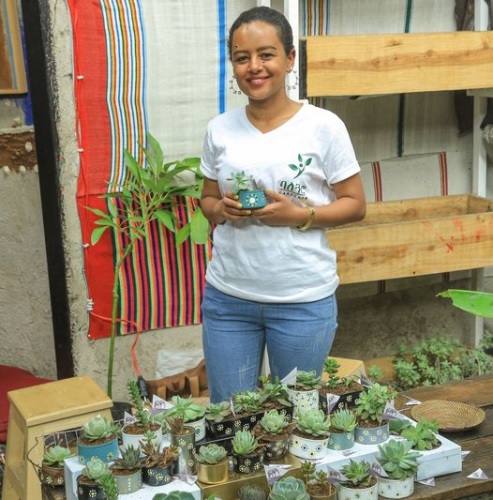
Lensa Mulatu is a self-trained artist and a professional architect. She is the owner of Arba Interiors, where she combines her passion for art and her architectural background. Her desire to create ornaments, interior designs, and artwork from waste materials has been a driving force in her work. Recently, Lensa had the opportunity to share her experiences with The Ethiopian Herald newspaper.
Lensa believes that decorating houses does not always require expensive materials. It simply needs a creative mindset that can transform trash into useful items. For example, many people discard used tuna cans without realizing their potential for house decoration. Lensa sees these mini cans as valuable resources that can be repurposed into unique and functional pieces. As the saying goes, “one man’s junk is another man’s treasure.” This holds true when it comes to upcycling. “By embracing upcycling, we not only contribute to waste reduction but also have the opportunity to decorate our homes by planting mini indoor plants in these tuna cans.”
One of the significant challenges Lensa faced in her journey was lack of capital. However, her passion and determination did not allow her to make excuses. With only 2,000 birr, she seized every available opportunity to produce interior decorations using discarded materials and tuna cans for indoor plants. When she showcased her products at bazaars, they attracted the attention of several individuals. This encouraged her to put more effort into her work, leading to an increase in her capital in a short period of time.
Lensa’s true passion for her profession and art is also reflected in transforming discarded glass bottles into art. She firmly believes that with creativity, passion, and effort, glass bottles can also be recycled and used to decorate houses while also serving as a source of income.
Glass bottle craft is a popular form of upcycling where bottles are transformed into unique and decorative pieces. Lensa utilizes discarded glass bottles and the tools she has at hand to create various indoor decorations, including wine bottles that are sold on the streets of Addis Ababa at reasonable prices.
According to Lensa, having a bachelor’s or master’s degree does not always guarantee a secure income. Capitalizing on one’s talent provides an alternative source of income and, most importantly, brings a sense of satisfaction. However, this does not mean that the path is always smooth. Acquiring recycling materials poses a challenge in itself, and finding the right market for the products is another hurdle to overcome.
When asked about the difference between art and architecture, Lensa explained that art allows for freedom of expression without constraints. On the other hand, architecture follows design principles such as balance, proportion, scale, and harmony to create visually appealing structures. These principles are often rooted in mathematical and geometric concepts. While art can also incorporate these principles, artists have more flexibility in their creative expression and may choose to challenge or subvert these principles.
In other words, architecture not only follows its own set of rules but also incorporates artistic elements and can be appreciated for its aesthetic qualities. Many architects find ways to incorporate artistic expression and creativity within the functional and technical requirements of their designs, making it a unique fusion of art and functionality.
Lensa’s journey as an artist and architect showcases the power of creativity, passion, and resourcefulness. Through her work, she not only creates beautiful pieces of art but also contributes to waste reduction and finds innovative ways to generate income.
Another area where Lensa’s hidden talent shines is Mandala art. She attributes her childhood experiences as a significant influence on her current achievements. As a young girl, she found joy in playing with color markers and expressing herself on sheets of paper. Creating various shapes and coloring them with her markers fueled her passion for art. As she grew older, her passion for creating something new using paint continued to grow, leading her to discover and enjoy “Mandala art.”
Mandala art is a form of geometric or symmetrical art that originated in ancient cultures, particularly in Hinduism and Buddhism. The word “Mandala” itself means “circle” in Sanskrit. A mandala is a circular design that is often intricate and symmetrical, with patterns and shapes radiating from a central point. It can take various forms, including drawings, paintings, sculptures, or even digital creations. Mandala art often incorporates highly detailed and repetitive patterns and designs, incorporating symbols, geometric shapes, flowers, animals, or other elements that hold symbolic meaning.
Using Mandala art, Lensa is able to create various artworks through framing and decorating circular glass mirrors. Just like her work with discarded tuna cans and glass bottles, the combination of Mandala art with glass mirrors reflected Lensa’s creativity and attracted customers.
Lensa believes that the reasonable prices she sets for her products, combined with their artistic nature, attract customers. This encourages her to produce more and fuels her dream of creating job opportunities for other Ethiopians. She also envisions exporting her products abroad to contribute to earning foreign currency for her country.
When asked what message she has for other Ethiopian youth who are solely dependent on one profession while having untapped talent within them, Lensa emphasizes that everyone has hidden and untapped potential. Failing to capitalize on those talents prevents youth from achieving their goals. She advises youth to be proactive and create opportunities for themselves rather than waiting for others to do it for them. In doing so, they must learn the art of balancing their current profession with the passion they carry in their hearts.
Lensa’s story serves as an inspiration for embracing creativity, exploring hidden talents, and finding ways to merge art with different aspects of life. Her journey showcases the power of passion, resourcefulness, and the ability to create opportunities for oneself.
BY LEULSEGED WORKU
The Ethiopian Herald October 19/2023





